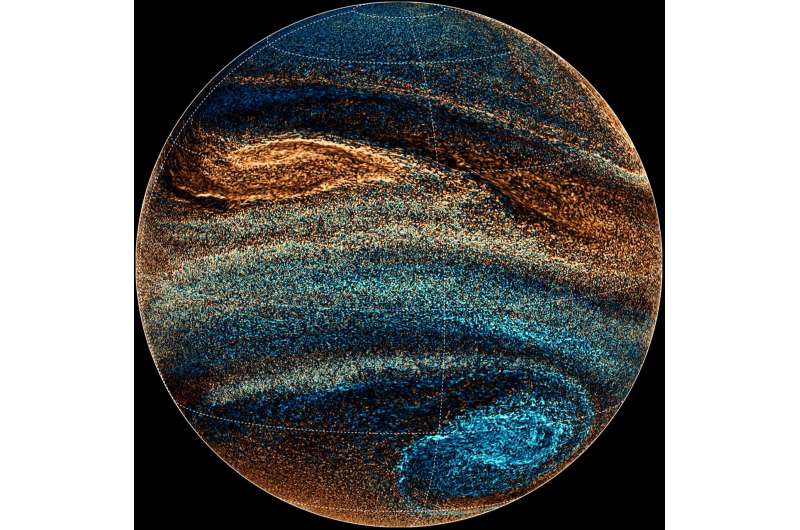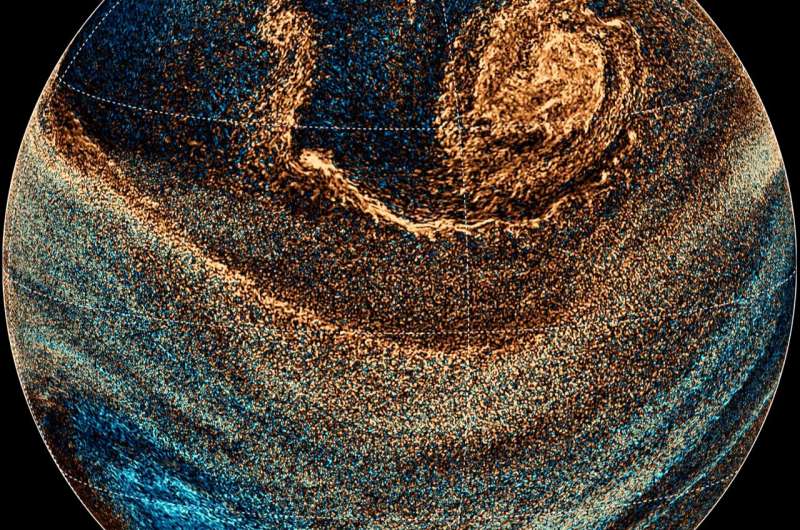January 18, 2024 feature
This article has been reviewed according to Science X's editorial process and policies. Editors have highlighted the following attributes while ensuring the content's credibility:
fact-checked
peer-reviewed publication
trusted source
proofread
Simulations show that exoplanets heated at deeper depths by their host stars display markedly different weather patterns

For many years, most astrophysical models assumed that planets beyond our solar system, known as exoplanets, are heated at similar depths by their host stars (i.e., stars like the sun around which planetary systems are formed). Analyses of recent observations by several collaborations using different telescopes, however, suggest that some exoplanets could absorb heat much deeper into their atmosphere than originally thought. Such exoplanets could display a weather pattern very different than has been expected from past modeling.
Researchers at California Institute of Technology, Flatiron Institute, and Brandeis University recently performed a series of simulations that confirmed this hypothesis. Their paper, published in the Physical Review Letters, suggests that hot-exoplanet atmospheres heated by their host stars at deeper depths lead to different persistent weather patterns.
"We were motivated to look at this problem by a recent analysis of JWST data for the planet WASP-96b, which showed that heating from its host star may be absorbed much deeper down in the atmosphere than we previously thought," Jack W. Skinner, Joonas Nättilä, and James Y-K. Cho, authors of the paper, told Phys.org. "This led us to look at past analyses of similar planets and found there are also other planets that are heated in this way."
The primary objective of the recent work by Skinner, Nättilä and Cho was to better understand how the depth in the atmosphere at which planets are heated affects their long-term weather patterns. This would allow a more accurate determination of how a planet would appear when observed using current and future space telescopes. It would also advance our understanding of climate and, ultimately, the habitability of exoplanets.
"The exact location and distribution of heating on exoplanets are currently not well known, but past studies have generally assumed one location and distribution," Skinner, Nättilä and Cho explained. "In reality, a more complete picture of the planet's atmosphere is needed to accurately interpret the observations."
As part of their study, the researchers performed hundreds of state-of-the-art supercomputer simulations. Their simulations solve a set of complex, nonlinear equations that describe how compressible fluids evolve on a rotating sphere. The same equations are used to predict the weather and climate on Earth and other planets in the solar system.

"We set these simulations up with the same parameters as two different hot Jupiters with different types of heating," Skinner said.
"The heating is based on retrievals by the James Webb and Hubble Space Telescopes (the latter is no longer in operation) of the hot-Jupiter exoplanet WASP-96b. The key difference from past simulation work is that our work uses a very efficient algorithm that enables our simulations to be performed at extremely high resolution (effectively around 50 times higher resolution than is usually done for these planets) on powerful supercomputers."
The algorithm employed by Skinner, Nättilä, and Cho significantly enhances their simulations, allowing them to capture small-scale flow structures such as eddies, fronts and waves. Collectively, these flow structures provide vital information about the weather patterns that could be observed on exoplanets, with unprecedented levels of detail and accuracy.
"Since heating and the small-scale structures it generates drive the flow, the type of heating determines the behavior of flows on these planets," Nättilä said. "Our simulations show the atmospheres of hot Jupiters are highly dynamic and turbulent, with powerful storms ranging from large to small sizes and intensity. The type and behavior of these storms depend on how the heating and cooling are redistributed on the planets."
The recent work by this research team provides interesting insight into the weather conditions that could be found in planets outside the solar system and how these conditions could be affected by the depth at which heat from host stars is absorbed.
The simulations run as part of this study are among the most detailed and accurate performed to date, and could inform the development of new models describing hot-exoplanet atmospheres.
"Modeling and understanding the flows on exoplanets are essential, as these flows move hot (and cold) patches of air (including chemicals and clouds) around the planet," Cho explained. "This creates bright and dark spots that move around the planet and are potentially observable by current and future space telescope missions, such as JWST and Ariel."
Skinner, Nättilä and Cho are enthusiastic about the results they obtained so far, as they ultimately demonstrate that exoplanet atmospheres are highly dynamic and variable, not unlike planet Earth. In addition, their work shows that while exoplanets can have very similar physical parameters and be situated in planetary systems with similar host stars, subtle differences between them could have a deep impact on their climate, weather and other observable characteristics.
"Our work has opened many more exciting questions about exoplanets and demonstrates that accurate models are now critically needed to accurately interpret current observations and to optimally plan future observations," Skinner, Nättilä and Cho added.
"With NASA's JWST and ESA's upcoming ARIEL missions, our work shows that we are now able to begin realistically constraining and testing fundamental physics theories and sophisticated computer models, as well as advance closer to robustly ascertaining which exoplanets may harbor life."
More information: Jack W. Skinner et al, Repeated Cyclogenesis on Hot-Exoplanet Atmospheres with Deep Heating, Physical Review Letters (2023). DOI: 10.1103/PhysRevLett.131.231201
Journal information: Physical Review Letters
© 2024 Science X Network





















